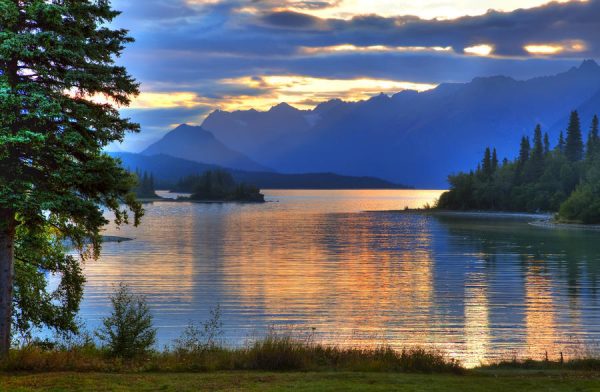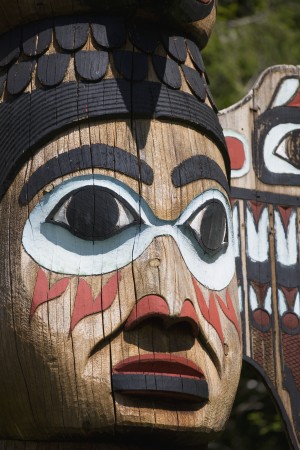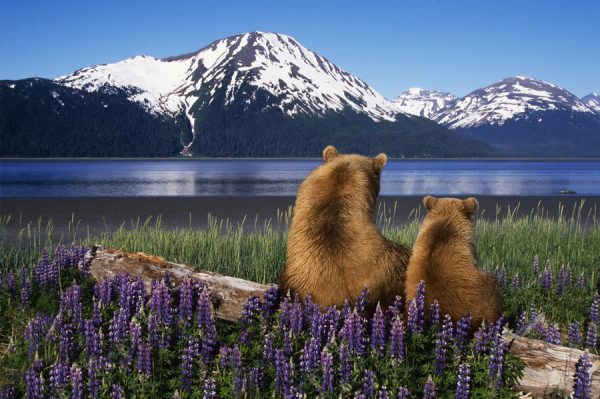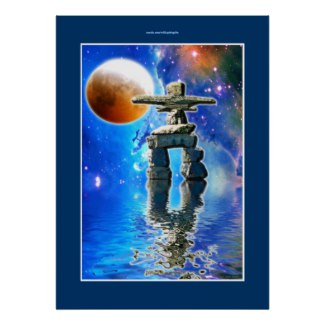The vast majority of Southcentral Alaska is on the road system so traveling by car in this region is common. If you drive to Alaska, first remember you will have to go through Canada to get here, so you will need a passport.
If you plan to bring your pet along, be sure to get a certificate of health from your veterinarian. You will need that to cross the Canadian border.
For more information on crossing Canada, visit the Department of Homeland Security’s page on Crossing the U.S. Border.
It is a long drive and you should be prepared with all of the safety equipment necessary for an extended road trip. It can be a long ways between services, so be prepared.

Sunrise On Lake Clark In Lake Clark National Park, Southcentral, Alaska – Buy Poster.
Daylight, Weather & Clothing
“Land of the Midnight Sun” isn’t just a clever term.
On summer solstice in June, the sun is up by 4:30 a.m. and sets just before midnight in Southcentral Alaska. That’s more than 19 hours of daylight! Don’t forget to get some sleep.
From summer solstice to winter solstice in late December, daylight hours slowly shrink to the shortest day when its light by 10 a.m. and getting dark by 4 p.m. Then the tide turns and daylight hours begin the ascent to summer solstice again.
Visit the Sunrise/Sunset website for a detailed calendar for any city at www.sunrisesunset.com.
Southcentral Alaska winters are cold, but it enjoys warm, sunny summer days averaging in the mid 60’s or sometimes even in the 70’s during June, July, and August, so bring some t-shirts and shorts for summer travel. But as with any place in Alaska, the weather can be unpredictable.
As a rule it is best to have layers available for the chance of a foggy morning or summer shower. Avoid any heavy winter gear, unless of course, you visit Southcentral Alaska in the winter. A light wind and water repellent coat is also good to have on hand.
The specialized gear you will need to bring will be minimal.
As a general rule, you need to dress in layers when you come to Alaska.
And don’t forget your sunglasses! Even in wintertime, Southcentral Alaska can have bright sunlight. Compounded with the snow it can be almost blinding.
Any specialized gear needed for a tour will most likely be provided by the tour company.
Other items to be sure to bring along are a camera and binoculars.
Mosquitoes
Mosquitoes are perhaps the most widespread and persistent of insects in Alaska, occurring in Alaska’s many miles of swampy tundra and lakes from early spring into the fall.
Mosquitoes are generally active in the early morning and at dusk and most bothersome in areas with stagnant water and little or no breeze. You can’t plan your summer vacation around the mosquito, but they are easily dealt with. Every corner store, supermarket and outdoor center will have a good selection of bug repellent; be sure to keep some on hand.
Southcentral Alaska Culture

Totem Bright State Historical Park, Ketchikan, Southeast Alaska – Click on image to Buy Poster
Alaska’s Southcentral region, encompassing Anchorage, the Kenai Peninsula and the Matanuska-Susitna Valley, features some of the best the state has to offer for cultural travelers.
Anchorage is home to the impressive Alaska Native Heritage Center, a unique cultural site dedicated to educating visitors about Alaska Native groups. The Center presents programs in academic and informal settings, including workshops, demonstrations and guided tours of indoor exhibits and outdoor village sites.
After visiting Anchorage, cultural travelers may want to rent a car and drive south on the Seward Highway to the Kenai Peninsula.
The Seward Highway was recently named an All-American Road and boasts some of the country’s most spectacular scenery. A stop in hip and funky Girdwood is a must on this road trip.
Located at the base of Mount Alyeska, the ski town is home to a group of artists who like the small-town feel of the place. Visitors can visit any number of small, unique galleries year-round or time their visit to coincide with the Girdwood Forest Fair, a midsummer arts and crafts event.
Continuing down the Seward Highway, visitors will eventually find themselves on the Kenai Peninsula. The Kenai area’s growing reputation as a place of creative expression is well deserved as it develops visitor-friendly cultural sites and centers.
The Kenai Fine Arts Center, located in Old Town Kenai, provides studio space for members of the Peninsula Art Guild and the Kenai Potters Guild. The guilds host monthly art exhibitions, maintain an artist sales gallery, and offer a variety of art workshops for adults and children.
The region is also rich in Gold Rush history. Visitors can raft down Six Mile Creek and see evidence of mining operations from days past.
Upon reaching the end of the road in Homer, visitors will arrive in a cultural mecca of sorts. The tight-knit, artsy community of Homer prides itself on its beatnik image. Galleries and small artisan shops can be found everywhere in this oceanfront community.
Native Alaskan Artwork
Wherever you go in Alaska, you’ll find unique, authentic Alaskan products and crafts.
These can include:
– Gold nugget jewelry and items carved from ivory and jade
– Handmade clothing and toys
– Collectors items made from animal skins, fur or bone
– Woven baskets of beach grass, bark or baleen
– Alaskan delicacies – canned and smoked salmon, wild berry products and reindeer sausage
– Native seal oil candles, beaded mittens, fur mukluks and miniature hand-carved totem poles
– Be sure to look for the “Made in Alaska” logo, which indicates an item genuinely manufactured in Alaska. If you find a silver hand logo, it identifies the item as a Native Alaskan handicraft.
– Handcrafted items made of walrus ivory and other by-products of subsistence hunting provide an income source for Native Alaskan artisans and a valuable investment for the buyer.
Be careful though – some wildlife products cannot be transported through customs without special permits. Visitors are advised to mail these souvenirs home to avoid confusion at the border.
Summer activities in Southcentral Alaska
- Hike in Chugach State Park, a parcel of land that runs along Anchorage’s eastern border.
- Fish for all five species of salmon on the Kenai Peninsula
- Take a water taxi from Homer to the seaside communities of Seldovia and Halibut Cove.
- Ride the Alaska Railroad along Turnagain Arm from Anchorage to Seward or from Anchorage to Fairbanks via Denali National Park & Preserve.
- Raft the Kenai, Matanuska or Sixmile River.
- Kayak the waters of Prince William Sound from Whittier.
- Shop for Alaska Native art at the Alaska Native Medical Center gift shop.
- Cruise among the icebergs of Portage Lake.
- Drive the Seward Highway from Anchorage to Seward, one of only a handful of designated All American Road.s
- See the terminus of the Trans-Alaska Pipeline in Valdez.
- Watch giant cabbages of up to 90 pounds be weighed in at the Alaska State Fair in Palmer.
- Cruise the College Fjords glaciers of Prince William Sound.
- Visit the Alaska Zoo in Anchorage.
- Kiss a moose at Big Game Alaska Wildlife Center in Portage.
- Visit Iditarod Trail Sled Dog Race headquarters in Wasilla.
- Hike Hatcher’s Pass in the Mat-Su Valle.y
- Visit the abandoned Kennecott Copper Mine at McCarthy.
Winter Activities in Southcentral Alaska
- Heliski in the mountains surrounding Valdez.
- Downhill ski and snowboard at Alyeska Ski Resort, Alpenglow or Hilltop Ski Area near Anchorage.
- Play snowshoe softball or go ice bowling at Anchorage’s Fur Rendezvous Festival.
- Fish for winter King Salmon in Homer.
- Ice climb the frozen waterfalls along Turnagain Arm near Anchorage.
- Take the Grandview Ski Train from Anchorage to Grand View twice a year on the Alaska Railroad for backcountry cross-country and telemark skiing.
- Visit the Alaska SeaLife Center.
Fishing, Fishing Licenses, and Sportsfishing
Southcentral’s coastal communities cater to the saltwater fishing enthusiast with all kinds of salmon and the famous Alaska halibut. Freshwater anglers can catch the salmon as they head up the rivers or cast for trout, northern pike or Dolly Varden in the myriad of lakes throughout the area.
Non-resident fishing licenses can be purchased just about anywhere from the corner grocery store to sometimes right on-board your charter vessel. You can even purchase your fishing license online.
Non-resident license fees are as follows:
1 day – $25
3 days – $45
7 days – $70
14 days – $105
Annual – $145
Refer to the Alaska Department of Fish and Game for fishing runs and more license information.
Wildlife Viewing

Grizzly Sow and cub, Turnagain Arm, Southcentral Alaska – Buy print.
The first thing to remember is that the “wild” in wildlife isn’t an arbitrary distinction. These animals are not tame and are not in a zoo. They roam free in their natural habitat and sometimes they roam free in yours. It isn’t uncommon for a moose to be strolling down a residential street looking for a tree to prune.
Wild animals in Alaska can be dangerous if they are provoked. They are also extremely protective of their young, so animals who have calves, cubs or some other kind of young, should be viewed at a good distance and with extreme caution.
Anchorage & Mat-Su Valley
It could take a lifetime to see all the wildlife that Alaska has to offer but Anchorage is a good place to start. Wildlife is an important part of everyday life in Alaska’s largest city.
A large moose population residing within the Anchorage bowl makes life unique and exciting for residents. Many migratory bird species visit the Anchorage area during spring and fall migrations. Anchorage is also within minutes of truly wild lands that are home to myriad animals from moose to bears to whales to birds.
Anchorage hot spots include points along Turnagain Arm to Girdwood and Portage Glacier Valley, as well as north to Palmer Hay Flats and Goose Bay.
Viewing Locations
- Anchorage Coastal Wildlife Refuge
- Arctic Valley
- Beluga Point
- Campbell Tract
- Chugach State Park
- Conner’s Bog
- Crow Pass Trail
- Eagle River Nature Center
- Goose Bay State Game Refuge
- Government Hill
- Kincaid Park
- Palmer Hay Flats Refuge
- Point Woronzof
- Potter Marsh
- Ship Creek
- Susitna Flats Refuge
- Trail to Point Campbell
- Upper Campbell Creek Gorge
- Westchester Lagoon
- Windy Corner
Kenai Peninsula
This rugged peninsula, some 200 miles long and 100 miles wide, has been called “Alaska in miniature”—every Alaska wildlife habitat type except Arctic tundra is represented here. It also boasts an extensive network of roads, waterways, and hiking trails that offer ample opportunity to observe wildlife in its natural surroundings.
Here are 65 sites that local residents have deemed some of the best places to see wildlife. We’ve divided the Kenai into four regions:
- Northeast Kenai follows the Seward Highway from the upper reaches of Turnagain Arm and across the Chugach Mountains to join the Sterling Highway as it hugs the Kenai River. Float the Kenai River or hike a chain of beautiful lakes to experience the essence of Kenai wildlife viewing.
- Northwest Kenai picks up the Sterling Highway as it crosses a vast network of rivers, lakes and wetlands on its way to the coast. The Kenai River flats, five miles upstream from the sea, draw birds, seals, moose and caribou within viewing distance of a busy highway.
- Southeast Kenai leads you down the Seward Highway to the town of Seward, once a fur trading post along the shores of Resurrection Bay. From here you can venture into the Gulf of Alaska and a wilderness coast of glaciers, islets, cliffs and fjords.
- Southwest Kenai follows the Sterling Highway from Anchor Point to Homer and across Kachemak Bay to Seldovia. On your way into Homer, stop and take a photo at the Baycrest Hill Viewpoint where you just might catch whales, sea otters, eagles, fishing boats and active volcanoes in a single shot.
Prince William Sound

Orcas, Bainbridge Passage, Prince William Sound, Alaska – Buy Canvas Print
Prince William Sound encompasses 3,800 miles of coastline, bounded to the east and north by the Chugach Mountains and to the west by the Kenai Peninsula.
Commercially important for the fishing and oil industries, the sound is also prized for its abundance of marine and coastal life, its rain forest of Sitka spruce and western hemlock, and its glacier-studded landscape.
The sound contains 150 glaciers including 17 tidewater glaciers, known for dramatically calving huge ice chunks into the sea.
More than 220 species of birds, 30 species of land mammals, and at least a dozen marine mammal species are found in the region. Bald eagles are plentiful along treetops and shorelines.
Among the estimated 200,000 seabirds that summer in the sound are marbled murrelets, black-legged kittiwakes, and glaucous-winged gulls.
Along western Prince William Sound, black bears may be seen on narrow beaches below mountainous, glacier-choked vistas.
To the east, including on Hinchinbrook, Montague, and Hawkins islands, brown bears roam their favored lowlands, and are most often seen fishing when the salmon are spawning.
Don’t forget to keep an eye out for moose and mountain goats as well. Resident marine mammals include humpback, sei, fin, minke, and killer whales as well as Steller sea lions, harbor seals, and sea otters, all of which reach some of their greatest numbers in Prince William Sound.
Though rugged and wild, the sound is easy to access. Through a tunnel roadway completed in 2000, the western Prince William Sound community of Whittier offers a gateway to this marine wilderness about an hour’s drive from Alaska’s largest city, Anchorage.
You can also access the sound from the north, at the port of Valdez, via the Richardson Highway.
The Alaska Marine Highway System provides year round service linking Whittier, Valdez, and Cordova. Check the ferry schedules at the Alaska Marine Highway website.
Viewing Locations
- Cordova
- Valdez
- Whittier
Wrangell–St. Elias Park and Glenn Highway

Chugach Mountains Along The Glenn Highway, Southcentral Alaska – Buy print.
Sprawled across the southeast corner of Southcentral Alaska and the northern tip of the Southeast panhandle, an immense but little-known national park lies along the US-Canada border.
Wrangell-St Elias National Park and Preserve is the largest national park in the US, a rugged land of high peaks, massive glaciers, and broad glacial rivers. It’s remote and undeveloped, beautiful and vast so, if you’re thinking of visiting, it’s best to plan and prepare ahead of time.
To access the park from Anchorage, one travels 200 miles along the Glenn Highway, a bypass that is an adventure in itself.
After leaving Anchorage and the more populated areas of the Matanuska-Susitna Valley, the Glenn Highway enters a rugged landscape. The road follows the Matanuska River as it winds through the Talkeetna and Chugach Mountains along a path carved over time by the Matanuska Glacier.
Continuing north past Sheep Mountain and through northern forests, the road climbs to Eureka Summit and offers panoramic views of four mountain ranges.
The road then drops back to parallel the Little Nelchina River, which spills into Copper River basin along the western boundary of the park. The park’s main visitor center is at Copper Center, just south of the junction of the Glenn and Richardson Highways.
Along the way, the road traverses diverse habitats inhabited by such animals as Dall sheep, black and brown bear, caribou and wolf. You’ll also pass an important migration corridor for many species of raptors. Boreal songbirds and owls inhabit the forests and trumpeter and tundra swans may be seen in the many lakes that form atop underlying permafrost.
Viewing Locations
- King Mountain State Recreation Site
- Long Lake State Recreation Site
- Matanuska Glacier State Recreational Site
- Caribou Creek
- Grand View Café & RV park
- Alascom Road
- Chickaloon-Knik-Nelchina Trailhead
- Gunsight Mountain Turnout
- Eureka Summit
- Lake Louise Road
- Glennallen
- Slana River
- Willow Lake
- Edgerton Highway
- Worthington Glacier State Recreation Site
- Blueberry Lake State Recreation Site
- Wrangell–St. Elias Visitor Center
- Slana Ranger Station/ Nabesna Road
- Chitina Ranger Station/ McCarthy Road

